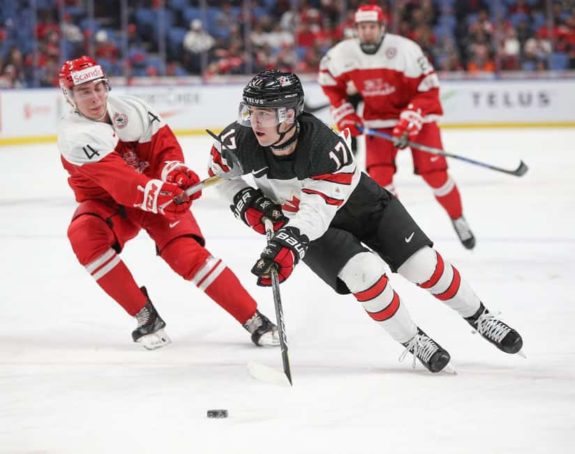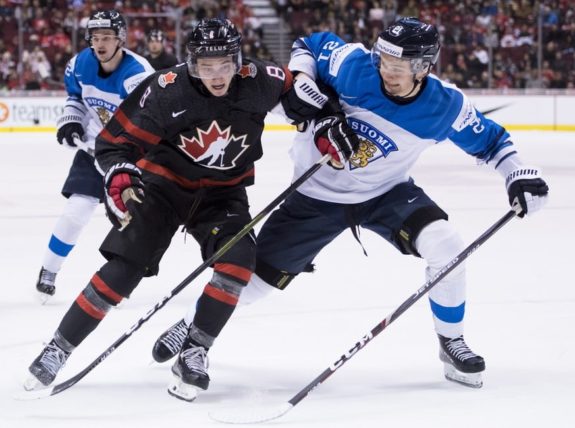![]()
There’s no more passionate fanbase in the hockey world than in Winnipeg. Attend a game at Bell-MTS Place when the Winnipeg Jets are in town and you’ll find ample evidence of that. The Winnipeg White Out in the playoffs drew national attention and became nearly as big a story as the playoff run itself. The decibel meter rose to levels usually reserved for stadiums that fit four times as many people and the crowds were a marketer’s dream.
Now imagine that same atmosphere, that same level of unbridled passion, during the gold medal game of the World Junior Championship. on Jan. 5. It hasn’t happened in Winnipeg in 20 years and it’s high time for that to change. First of all, the idea here is not to bash the most recent WJC host. In fact, commentators and fans alike recognized Victoria and Vancouver as some of the best hosts the tournament has had in recent years.
Because I’ll probably forget post-game, congrats to BC on putting on a great World Juniors. Crowds in Vancouver and Victoria were great, even after Canada went out early. Just love it here every time we come.
— James Duthie (@tsnjamesduthie) January 6, 2019
But with Red Deer and Edmonton due to host the tournament the next time it is in Canada in two years and with Edmonton having hosted as recently as 2012, Winnipeggers must be wondering what they have to do to attract the IIHF’s attention. Frankly, it’s surprising it’s been this long.
With attendance at the WJC publicly fledgling just last year in Buffalo, you’d think the IIHF would want a market that will eat their hockey up. And lest you think this was just a Buffalo problem, the tournament had similar concerns in 2017 in Toronto and Montreal.
Winnipeg More Than Big Enough
Some may raise concerns over the size of Winnipeg as a city to host a tournament like this. With cities like Toronto, Montreal, and Vancouver being recent hosts, Winnipeg is admittedly a smaller market by comparison. That size is no guarantee of success, however. If size were all it took, New York City and Los Angeles ought to have hosted by now. And attendance, as mentioned above, was a concern in many of those larger markets.

Winnipeg sits with a population of just over 700,000 according to the latest census data. Ignoring the fact that it’s close enough to draw from Brandon, Grand Forks, and even Regina, that’s more than a big enough region to sustain a tournament this size. Malmo, Sweden, the tournament host in 2014, is not half of Winnipeg’s size at just over 300,000 people. Helsinki, the 2016 host that knocked it out of the park as the Finns went on a medal run, is also smaller at about 631,000.
Meanwhile, Grand Forks, with a population of just under 60,000, hosted the greatest team the World Juniors has ever seen in 2005 and absolutely knocked it out of the park. That tournament’s success, by the way, was in no small part due to hockey fans making the short drive across the border from Winnipeg.
“The Grand Forks and Thief River Falls event was, by far, the most attended World Juniors ever in America and, at the time, the No. 2-attended World Junior Championship anywhere.” (From ‘World Junior days likely done in Grand Forks’ – Grand Forks Herald – 07/28/15)
Then there’s Saskatoon-Regina, the joint host cities who beat out Winnipeg to host in 2010. Between the two of them, they add up to just about 500,000 people. I don’t recall attendance concerns or market size issues being prevalent there. The reason those issues never came up is that the fans in those two cities filled the rink every night. After all, when you can only fit so many people in an arena, the desire of the population to fill that arena is what matters. Winnipeg has that in spades.
Winnipeg Brings the Noise
Anyone who’s ever attended a Jets game can tell you how passionate Winnipeg hockey fans are. They’re knowledgeable (by and large) and fervently devoted to their favorite sport. These are exactly the sort of fans the IIHF should want to attract.
Of course, it’s easy to get excited about a conference final playoff game, but Winnipeg has done well hosting other IIHF events in the past. From the Women’s World Championship in 2007 to the U17s in 2012, the IIHF has asked Winnipeg to dance a few times but hasn’t stuck with them for the slow dance at the end since 1999.
I wonder how many empty crowds the world juniors have to go through before they come back to Winnipeg? I remember in 99 going to Slovakia against Russia being sold out. Bring it back to the peg
— Daryl Thiessen (@DarylThiessen) January 5, 2018
You could forgive Winnipeg for being a little put out about that. In those 20 years (it will be at least 23 when the current host schedule plays out), the tournament has seen several cities host more than once, including Buffalo, which had the head-scratching attendance issues in 2018.
But you can bet all will be forgiven if the IIHF decides to return the tournament to Winnipeg. Fans will line up to buy tickets in droves. People from Regina, Brandon, Grand Forks, and other smaller markets will make the trip by car. Fans from elsewhere will have an easy time getting to Winnipeg due to its central location.

By all accounts, Winnipeg is ready, willing and able to host. The city was preparing a joint host proposal with Saskatoon for this year’s tournament that ultimately bore no fruit. Winnipeg wants this tournament back.
For the IIHF, pressured as they were last year by concerns about ticket prices and fan disengagement, Winnipeg is a free space on the bingo card. The prairie city perhaps most famous for its bad weather and love of hockey would be a banner for them to hold up against such criticism when fans pack Bell-MTS place.
One of these days, they’ll realize they’ve been sleeping on one of the best options that has been right under their nose. And Winnipeg will forgive them for it. They will also reward the IIHF with a crowd that will do what it does best: shake the rafters with cheers.